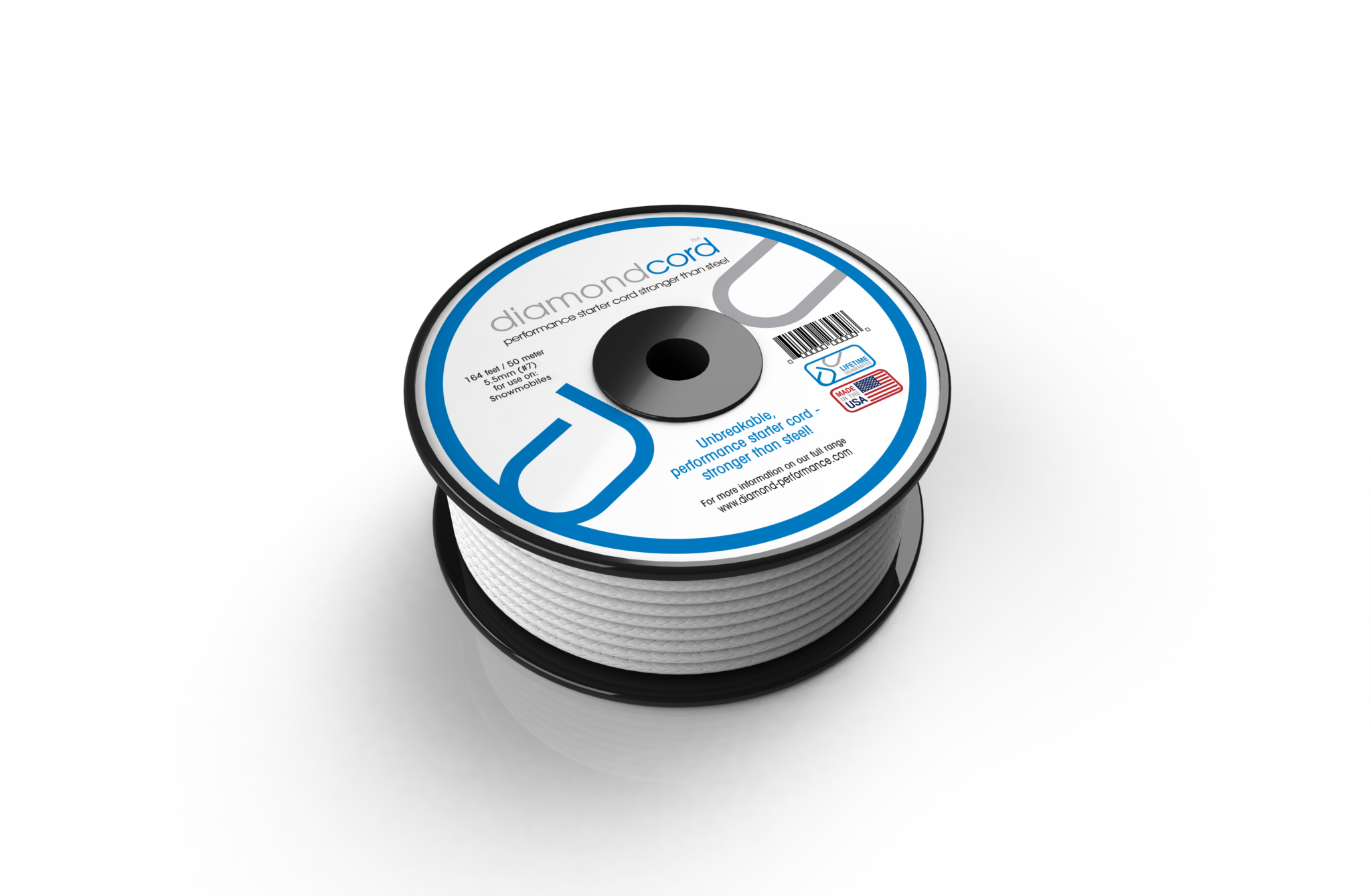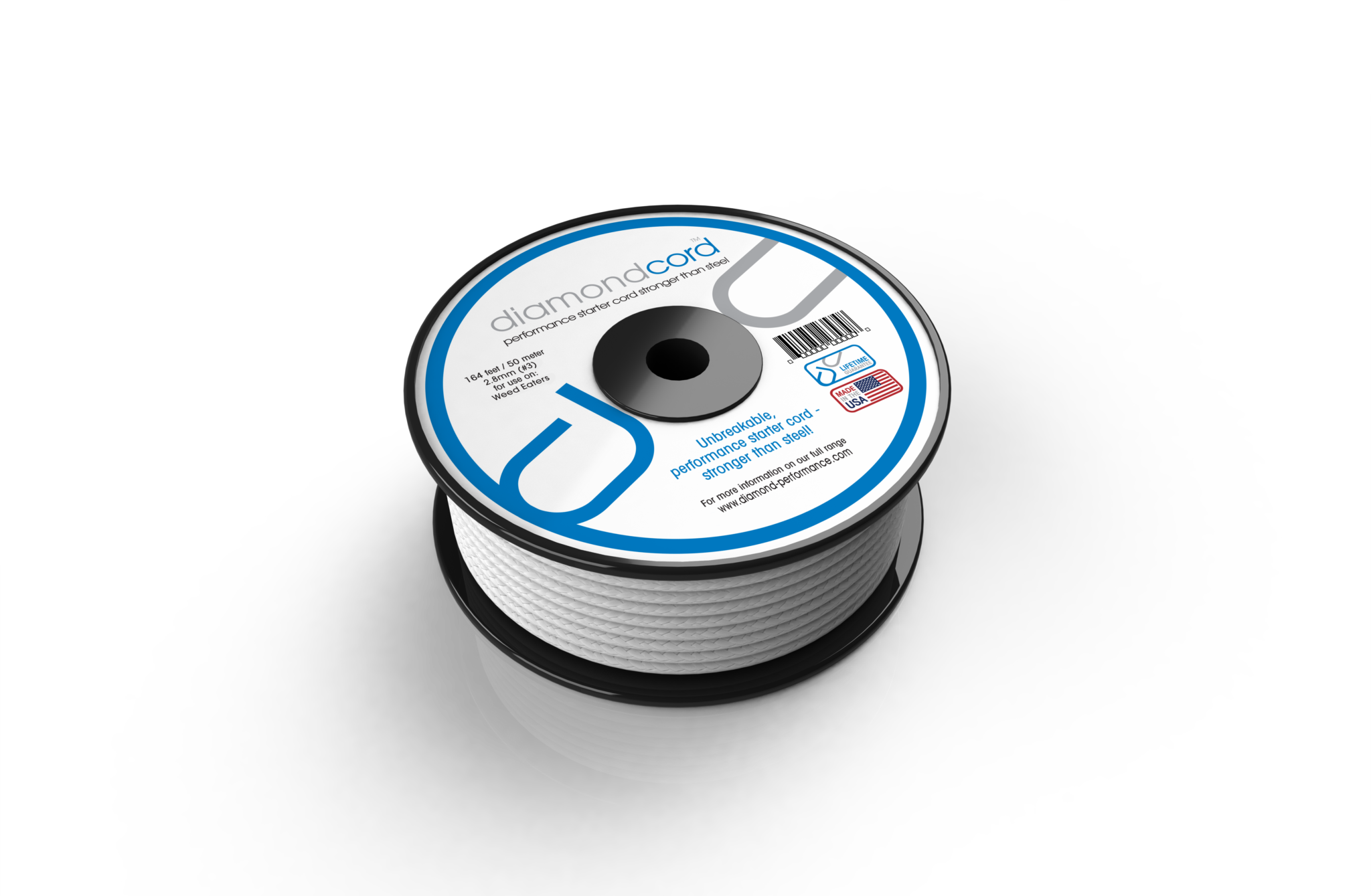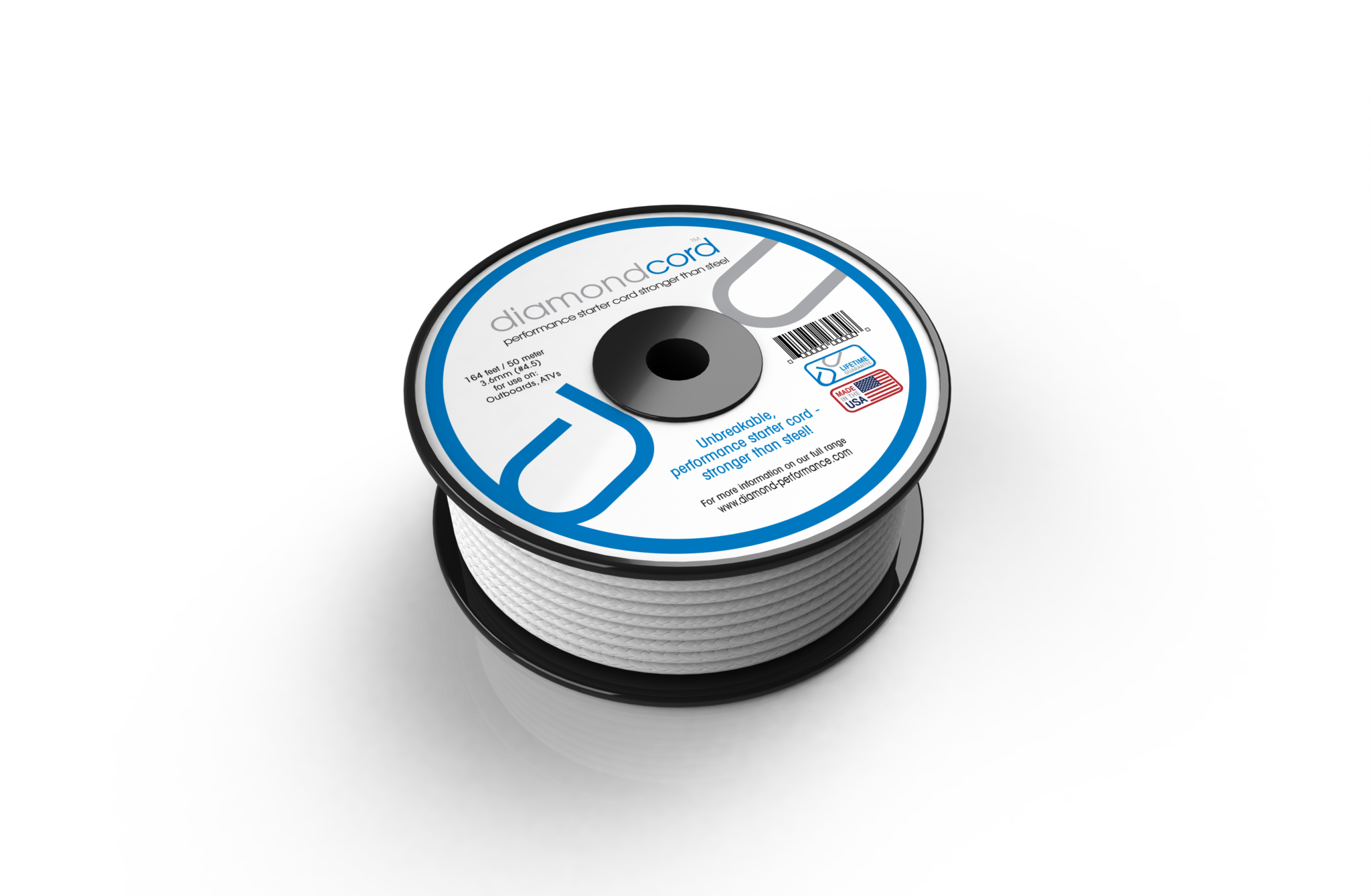Diamond Cord – Unbreakable Pull Start Cords
Our diamondcord™ are the world’s strongest and most durable, unbreakable pull start cords. Our unbreakable starter cord uses patented technology that is five times stronger than steel. The high-performance design allows smoother pulling for lawn mower pull cords and any other recoil starter rope applications. Backed by our lifetime guarantee, using diamondcord™ eliminates downtime and inconvenience from broken pull start cords. There is also no monetary loss from frequent cord replacements. Applications include lawn mower pull cord, generator pull cord, snow blower pull cord, chainsaw pull cord, snowmobile pull cord, and other recoil rope started devices. Our diamondcord™ can replace nylon/polyester cord and steel cable. It is also ideal for use as an emergency tow-rope for small recreational vehicles, tie-up rope, light-gauge winch line, and other general rope use applications.

- NON CORROSIVE: A significant benefit of diamondcord™ is its anticorrosive properties. It will survive marine and extremely corrosive environments.
- HEAT-RESISTANT: diamondcord™ can handle exposure to temperatures of up to 600℉ / 315℃ and will not burn.
- ABRASION RESISTANT: diamondcord™ has excellent abrasion resistance and will outperform Kevlar by 15 to one in abrasive applications.
- MADE IN USA: diamondcord™ is made in the USA
- STRONGER THAN STEEL: diamondcord™ is five times stronger than steel
- LIGHT ENOUGH TO FLOAT: diamondcord™ is a floating cord, yet is stronger than steel.
- CHEMICAL RESISTANT: In harsh environments diamondcord™ has unique chemical resistant properties




All diamondcord™ products are backed by our lifetime guarantee. You will never need to buy replacement starter pull cord again.
diamondcord™ products are available at select retail locations worldwide.
diamondcord™ testing the unbreakable pull start cords!
A comprehensive report on the testing done to produce diamondcord™ unbreakable pull start cords
Abstract
Gasoline engines are used on power tools, such as chain saws and snow blowers, and on vehicles, such as snowmobiles, personal water craft, and all-terrain vehicles. Many of these tools and vehicles have a manual starter pull cord mechanism to provide the initial impetus to start the engine. The pull cord is wound around a starter pulley connected to the engine’s flywheel and crankshaft. To start the engine, a user pulls the starter cord to unwind it from the pulley and impart rotation to the flywheel and crankshaft.
Engine starter pull cords are typically made of nylon fiber. Nylon pull cords sometimes do not provide enough impetus to start the engine on the first pull, or even on subsequent tries. These nylon starter cords wear out and break, rendering the engine and hence the tool or vehicle inoperable. In some applications, for example – outboard engines, all-terrain vehicles and especially snowmobiles – inability to start the engine can be life threatening.
This paper describes an improved engine starter pull cord made of Diamond Performance fiber. Diamond Performance fibers are much stiffer than nylon and other conventional fibers. Diamond Performance fibers are also significantly stronger and are far more resistant to wear than conventional fibers.
In laboratory abrasion tests, a typical nylon starter cord failed at an average of 22,677 pulls. DiamondCord failed at an average of 1,431,852 pulls.
In field trials with power tool engines equipped with the diamondcord™ improved starter pull cord cords, experienced users reported that it is easier to start the engine than the same engine equipped with a conventional nylon pull cord.
The reason that it is easier to start the engine is that the engine flywheel turns much faster with an diamondcord™ pull cord. An analysis shows that a typical power tool flywheel can turn about 45% faster with the diamondcord™ pull cord than with a nylon pull cord.
Introduction
Gasoline internal-combustion piston engines are used on power tools, such as chain saws, lawn mowers and snow blowers, and on vehicles, such as snowmobiles, outboard motor boats, and all-terrain vehicles.
Many of these tools and vehicles have a manual starter mechanism employing a pull cord. Figure 1 is a schematic of a typical small one-cylinder gasoline engine with a starter-cord mechanism. The starter pull cord is wound around a pulley that is coupled to a flywheel through a clutch mechanism (not shown). The flywheel is connected to the engine’s crankshaft. Rotation of the crankshaft drives the piston through a connecting rod. When the cord is pulled out, the crankshaft rotates and drives the piston back and forth within the cylinder. The piston motion compresses a fuel-air mixture within the cylinder. A spark ignites the fuel-air mixture near the top of the stroke, driving the piston down.
The flywheel must be turning fast enough to start the engine. If the flywheel is not turning fast enough, the fuel-air mixture can leak around the piston, and there is insufficient compression to support ignition. If the flywheel is not turning fast enough, the spark fires before sufficient compression is achieved, and the fuel-air mixture fails to ignite. If the flywheel is not turning fast enough, ignition can occur before the piston reaches the top of its stroke, and the explosion opposes the piston motion and does not impart sufficient momentum to the flywheel to drive the engine through a second compression cycle. Motor starter pull cords are typically made of nylon fiber. Nylon pull cords sometimes do not provide enough impetus to start the engine on the first pull or even subsequent tries. Nylon starter cords wear out and break, frequently at inopportune moments – rendering the engine, and hence the tool or vehicle inoperable. In some vehicles, especially marine outboard engines, all-terrain vehicles and snowmobiles, inability to start the engine can be life threatening.
Research has now led to the development of an improved high-strength, diamondcord™ fiber starter pull cord. The original intention was to develop a starter pull cord that is stronger and more resistant to wear and breakage than nylon starter pull cords. An unexpected benefit is that the zero stretch diamondcord™ starter pull cord provides greater impetus and thus is more apt to start the engine on the first pull.

Figure 1
Schematic of Engine Starter Pull Cord and Engine Components
Description of Improved Starter Cord
Two types of starter pull cords were tested and compared in this program, a typical nylon cord and diamondcord™.
The nylon pull cord was a commercially available 4.5 mm (0.4 in.) diameter kernmantle-construction cord, sold as an after-market replacement starter pull cord. The new break strength of this cord was tested and determined to be about 3 kN (700 lb). The diamondcord™ exhibits high strength, abrasion resistance, and stiffness.
The diamondcord™ was 3.2 mm diameter, 12-strand hollow-braid cord construction. Its new break strength is about 9.6 kN (2,000 lb).
Figure 2 compares the load vs. strain characteristics for the diamondcord™ cord and the nylon cord of the same size, 3.2 mm diameter.
The diamondcord™ stretches by about 5.5% of its original length at its 9.6 kN break strength. The nylon cord stretches by about 37.5% at its 3 kN break strength. At 1 kN (225 lb) tension, the diamondcord™ stretches about 2%, and the nylon cord stretches about 17.5%. The nylon cord stretches almost nine times more than the diamondcord™ at this tension.
Durability Testing
Test Setup
Specimens of the nylon and diamondcord™ starter pull cords were abrasion tested by Dr. Nichols at Tension Technology International’s test laboratory in Arbroath, Scotland.
A special three station cord abrasion tester was used in these tests. This tester is essentially a scale-up of the yarn-on-yarn abrasion tester used in the Cordage Institute yarn abrasion test.
In these tests, the cord was not inter-warped in the manner described in those standards. Instead it was run was run through the eyelet at an angle of 20 degrees.
A tensioning load of 4.4 kg (10 lb) was hung on the end of the specimen. The specimen was cycled back and forth through the eyelet with a stroke of 38 mm (1.5 in.) at about 50 cycles per minute.
Water was applied to the specimen while stroking to simulate conditions which might be encountered in service. The abrasion resistance of nylon yarn is reduced when wet.2 Wet conditions are frequently encountered in power tool use and especially in outboard motor boats.
As used in an engine, there is high tension on the pull cord as it is being pulled, but there is little or no tension as it is retracted into the engine. Because the cord is under high tension during both strokes of a cycle on the abrasion test machine, each test machine cycle is equivalent to two pulls on the starter pull cord as it is used in an engine.
Test Results
The test results are plotted in Figure 3.
Three diamondcord™ pull cord specimens were tested until failure. These failed at 1,205,894, 1,356,800, and 1,732,862 pulls respectively. The average pulls to failure, 1,431,852 pulls, is plotted in the figure.
Three nylon pull cord specimens were tested in the same manner. These nylon pull cords were judged to have failed when the sheath of the kernmantle construction completely failed, even though some internal yarns might still be intact. These failure points were at 4,400, 27,000 and 42,000 pulls respectively. The average pulls to failure, 22,677 pulls, is plotted in the figure.
Figure 4 shows the appearance of an diamondcord™ after 60,000 pulls, more than twice the average pulls to failure of the nylon cords. The diamondcord™ lasted more than 50 times longer than the nylon pull cords.
During some improved starter cord tests, cycling was suspended after a predetermined number of pulls. The cord was then disassembling into its twelve component strands and each strand was tested for retained strength. The total retained strength of the cord was then calculated by summation the individual strand strengths and multiplying by the cord efficiency factor. (The efficiency factor is the ratio of the new strength of the cord divided by the sum of the new individual cord strengths.) These retained strengths are plotted in Figure 4.
Figure 4
diamondcord™ starter pull cord after 60,000 pulls (30,000 cycles). The nylon cord failed at an average of 22,677 pulls.
Analysis
A dynamic analysis was performed to compare the flywheel speed achieved using a nylon starter pull cord with that using an diamondcord™ Unbreakable Pull Start Cord. This analysis modeled pulling the cord a distance of 800 mm (32 in.) in one second. It assumed the angular momentum inertia of the flywheel and crankshaft was 0.007 kg mm2 (23.7 lb ft2). It assumed the moving friction coefficient of all parts was 0.13 kN (30 lb). The results of the analysis are plotted in Figure 5. The handle pull distance is plotted against the left axis. The resulting flywheel speed in revolutions per second is plotted on the right axis.
With a nylon pull starter rope, the flywheel reaches 68 rpm at the end of the pull. With a diamondcord™ Unbreakable Pull Start Cord under the same conditions, the flywheel reaches 100 rpm at the end of the pull.
Using the diamondcord™ Unbreakable Pull Start Cord, the flywheel speed is about 45% greater. The significantly greater flywheel speed is the reason it is easier to start a gasoline engine using the diamondcord™ starter pull cord.
Explanation
There are many flywheel-speed related factors which influence the ability to start a small gasoline internal combustion piston engine.
The air-fuel mixture should be sufficiently compressed before the spark is set off, for otherwise ignition will not take place. If the flywheel is not turning fast enough, sufficient compression is not achieved, and the fuel air mixture fails to ignite.
The compression achieved in the engine cylinder can be diminished by leakage around the piston. If the engine turns faster, there is less leakage and more compression, and the likelihood of starting the engine is greater.
Ignition should take place just before the piston reaches the top of its stroke. If the flywheel is not turning fast enough, the explosion opposes the piston motion and does not impart sufficient momentum to drive the engine through a second compression cycle.
When ignition does not occur on the first compression cycle, the number of additional compression cycles which the engine goes through is a function of the flywheel angular momentum. If the flywheel rotates faster, more compression cycles will take place, and the likelihood that the engine will start is greater.
The spark which ignites the air-fuel mixture is usually energized by electric power voltage generated by a magneto attached to the shaft. The magneto-generated voltage is a function of the speed of revolution. If the engine shaft turns faster, there is more voltage, the spark has more energy, and the likelihood of starting the engine is greater.
Summary and Conclusions
An improved small gasoline engine starter pull cord, called diamondcord™, has been developed.
The diamondcord™ pull cord is much more durable than conventional nylon pull cords. In laboratory abrasion tests, the diamondcord™ pull cord lasted an average of more than 1,400,000 pulls, while a nylon pull cord lasted an average of about 25,000 pull cords. The diamondcord™ pull cord lasted more than 50 times longer.
Users report that it is easier to start an engine with the diamondcord™ pull start rope. A dynamic analysis calculation showed that, at the end of the cord pull action, the flywheel rpm is about 45% greater with the diamondcord™ pull cord than with a nylon pull cord.
Figure 5
Dynamic Analysis of Flywheel Speed Achieved with diamondcord™ and Nylon Pull Starter Cords.
Contact us for further details!
Unbreakable pull start cord pull starter cord pull start rope pull starter rope
Unbreakable pull start cord pull starter cord pull start rope pull starter rope Unbreakable pull start cord pull starter cord pull start rope pull starter rope Unbreakable pull start cord pull starter cord pull start rope pull starter rope Unbreakable pull start cord pull starter cord pull start rope pull starter rope Unbreakable pull start cord pull starter cord pull start rope pull starter rope Unbreakable pull start cord pull starter cord pull start rope pull starter rope Unbreakable pull start cord pull starter cord pull start rope pull starter rope Unbreakable pull start cord pull starter cord pull start rope pull starter rope Unbreakable pull start cord pull starter cord pull start rope pull starter rope Unbreakable pull start cord pull starter cord pull start rope pull starter rope Unbreakable pull start cord pull starter cord pull start rope pull starter rope Unbreakable pull start cord pull starter cord pull start rope pull starter rope Unbreakable pull start cord pull starter cord pull start rope pull starter rope Unbreakable pull start cord pull starter cord pull start rope pull starter rope Unbreakable pull start cord pull starter cord pull start rope pull starter rope pull starter cord pull start rope pull starter rope pull starter cord pull start rope pull starter rope pull starter cord pull start rope pull starter rope pull starter cord pull start rope pull starter rope pull starter cord pull start rope pull starter rope pull starter cord pull start rope pull starter rope pull starter cord pull start rope pull starter rope pull starter cord pull start rope pull starter rope pull starter cord pull start rope pull starter rope
| Weight | 3 kg |
|---|---|
| Dimensions | 40 × 30 × 40 cm |
| Pre-cut lenghts | 2.80 mm – 10 feet, 2.80 mm – 20 feet, 2.80 mm – 30 feet, 3.20 mm – 10 feet, 3.20 mm – 20 feet, 3.20 mm – 30 feet, 3.60 mm – 10 feet, 3.60 mm – 20 feet, 3.60 mm – 30 feet, 5.50 mm – 10 feet, 5.50 mm – 20 feet, 5.50 mm – 30 feet |
Diamond Performance no-hassle guarantee!
Isn’t it annoying when you pay for something, and then it doesn’t work or it breaks after you bought it?
Even worse, when you contact the company who sold you the product, they don’t do anything to make it right.
They simply shrug it off, mumble a meaningless apology, or worse yet, they make it sound like it was your fault!
You’ll never be treated that way in dealing with us!
We offer a no-hassle, lifetime guarantee on all product lines we sell!
And when we say no-hassle, we mean it! If you have an issue with any diamond Performance product we provided, this is what we’ll do:
- If our products break or fail, in any way, due to a manufacturing defect or natural wear and tear, we replace it at no cost to you, period!
- Simply send us a picture of the failed product and we’ll immediately ship out a replacement ( zero shipping cost to you! ), and that’s how we offer a truly hassle-free guarantee.
We stand by our products with what we believe is the best No Hassle Guarantee in the world!
At Diamond Performance, that’s never the case!










Reviews